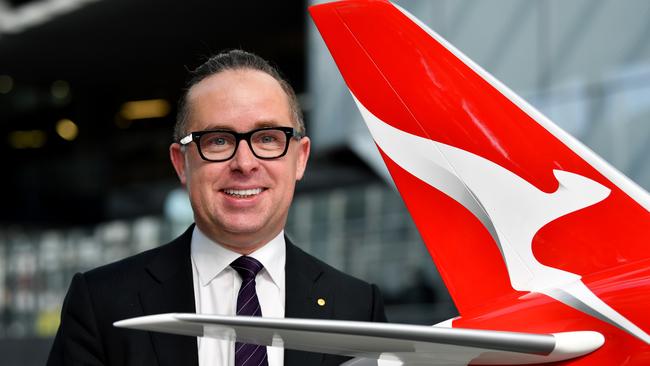For Qantas’ Alan Joyce, flights of fancy become a long-haul reality
If Alan Joyce ever needed further endorsement for his Project Sunrise, he got it in the new Qantas numbers.

If Alan Joyce ever needed further endorsement for his much-vaunted Project Sunrise, he got it in the numbers Qantas released yesterday on the performance of its landmark Perth to London ultra-long-haul flight.
Since the first non-stop version of the Kangaroo route launched in March this year, the seat factor — that is the number of occupied seats on each flight — is at 92 per cent. Business class is even better at 94 per cent, while premium economy is also very strong.
International boss Alison Webster revealed yesterday that its forward bookings on the route were equally strong, while the route has the highest customer satisfaction rating in the Qantas network.
The figures are a vindication for Joyce of his move last year to challenge Boeing and its rival Airbus to stretch the maximum flight distance of their next generation of long-haul planes to fly the direct routes from Australia’s east coast to New York and London — the so-called Project Sunrise.
While the Perth-London leg takes 16-17 hours, Project Sunrise flights would take up to 22 hours.
Joyce said yesterday that after briefings over the past year from Boeing and Airbus, he was now confident both manufacturers could deliver the aircraft.
The challenge will be to convince his pilots to amend their EBA to allow them to undertake such long sectors and overcoming the regulatory hurdles to have his new batch of super fuel-efficient aircraft in the skies by 2022.
But passengers it seems — so far — need no convincing.
Their experiences on the ground have already been enhanced by the initial work of researchers from Sydney University’s Charles Perkins Centre (CPC), which has led to Qantas introducing unique features at its Perth transit lounge including outdoor areas, lighter food and “light therapy” in shower suites.
On average, 70 per cent of customers are also taking yoga classes in the lounge ahead of their flight.
The CPC researchers have also been conducting an in-flight wearable technology study with a select group of frequent flyers on the sector.
Early results indicate a lower level of jet lag on the route than others in the Qantas network.
Now Qantas is surveying 12,000 of its top frequent flyers to get their opinions on introducing other innovations such as an exercise zone on board, a communal bar, a dining or self-service cafe zone, a creche, work stations or even converting some toilets into “change and refresh” stations.
At the same time the introduction of the Perth-London sector and the decision to shift its international hub to Singapore away from Dubai and funnel more European customers through its alliance partner Emirates is helping the Qantas bottom line.
The benefit of the change to the Singapore hub is estimated at $80 million per year going forward.
It is a far cry from just four years ago, when Qantas International was Joyce’s problem child, losing $500 million.
Last year it made nearly $400 million and Joyce now has the confidence to push the boundaries of ultra long-haul flying further than any of his contemporaries on the planet.





To join the conversation, please log in. Don't have an account? Register
Join the conversation, you are commenting as Logout